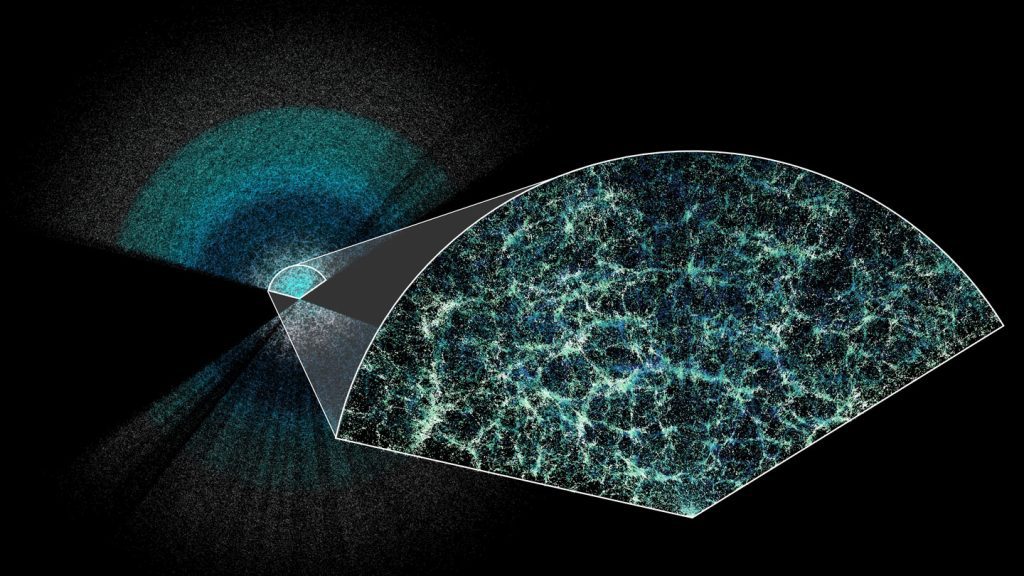A large survey of outer space is revealing new information about one of the most mysterious aspects of the universe, dark energy. Interestingly, when combined with other observations, the data suggest that dark energy, which is usually thought to maintain a steady density over time, might change alongside the universe.
The result greatly excites the cosmology community, according to physicist Daniel Scolnic of Duke University, who was not part of the new study.
Dark energy, a hidden mystery that causes the universe to expand faster as time goes on, is not well understood, even though it makes up most of the universe. To explore this puzzle, the Dark Energy Spectroscopic Instrument, DESI, has created the largest 3-D map of the universe up to now, as reported by researchers on April 4 in 10 papers posted on the DESI website. DESI website, and in presentations at a meeting of the American Physical Society held in Sacramento, Calif. By studying patterns in the distributions of galaxies and other objects on that map, scientists can figure out how the universe expanded over time. Although consistent with the standard view of the universe held by cosmologists, the data also allow for the possibility that dark energy’s equation of state, which describes how the pressure of dark energy relates to its density, might change over time. This would mean a major shift in scientists' understanding of the universe’s history.
The study looks at the project’s first year of data, mapping the locations of 6.4 million galaxies and quasars — the bright centers of very active galaxies. This map allows scientists to estimate the rate of expansion of the universe, thanks to a useful size reference present in the universe. Sound waves in the early universe created patterns in the density of matter in the universe, known as baryon acoustic oscillations. As galaxies form, those density variations persist, causing galaxies to be more likely to be separated by a specific distance. This distance acts like a ruler, which is stretched by the expansion of the universe. Measuring the size of that ruler over various eras of the cosmos can show how the universe expanded.
The scientists divided the universe into seven time periods, stretching back to 11 billion years ago, and measured its expansion over time. The more recent time slices corresponded to different types of galaxies. Looking back further in the universe’s history, the light from galaxies becomes too faint. So scientists turned to distant quasars and to measurements of how hydrogen gas absorbs the quasars’ light. The DESI scientists then compared their data to the standard cosmological theory, known as lambda CDM, in which dark energy’s density is assumed to be constant over time. The data matched that lambda CDM picture well. However, they also considered a theory in which dark energy’s behavior, specifically its equation of state, could change over time.On its own, the DESI data couldn’t precisely determine how dark energy evolved. So the team combined their data with studies of supernovas, exploding stars, to improve the estimate. This combined data fit better with an evolving dark energy than with one that was unchanging. Depending on the set of supernova data the researchers used, the significance of that effect was more than 3 sigma.SN: 3/4/193 sigma is considered an intriguing hint. In physics, 5 sigma is the gold standard for discovery, while 3 sigma is considered intriguing. “It’s definitely not discovery level, but it’s definitely like, this is exciting,” Scolnic says. “It’s not nearly as ‘vanilla’ as I think people might have been expecting.”
It may help to have more information to understand the situation better. DESI physicist Nathalie Palanque-Delabrouille from Lawrence Berkeley National Laboratory in California says they have a lot more data coming that will confirm the hints they're seeing. DESI scientists will gather five years of data, cataloging 3 million quasars and 37 million galaxies.
These initial results show that DESI scientists are making progress. Astrophysicist Michael Wood-Vasey of the University of Pittsburgh says that with more data, they can achieve their goals of understanding dark energy and determining if there's a deviation from lambda CDM. However, he is not very excited about potential hints of new physics because he tends to be cautious.
Cosmology is already dealing with controversy.
beset with controversy
over measurements of the Hubble constant, the current rate of the universe’s expansion (
). Different methods of measuring this number lead to conflicting results. DESI’s measurements do not resolve this Hubble constant tension. However, if scientists move away from the standard lambda CDM model, this could change the Hubble constant situation. DESI collaborator Dillon Brout, a physicist at Boston University, says that the tension is based on the assumption that the lambda CDM model is correct, and moving away from it could create a major problem. A year of data from DESI, the Dark Energy Spectroscopic Instrument, suggests that, contrary to expectations, dark energy might change over time. over measurements of the Hubble constant, the current rate of the universe’s expansion (SN: 7/30/19). Different ways of measuring that number produce results that clash. DESI’s measurements don’t resolve that Hubble constant tension. But if scientists move away from their standard lambda CDM model, that could change the Hubble constant situation. That’s because the tension is based on the assumption that the lambda CDM model is correct, says DESI collaborator Dillon Brout, a physicist at Boston University. “This … would potentially blow the [Hubble] tension wide open.”



